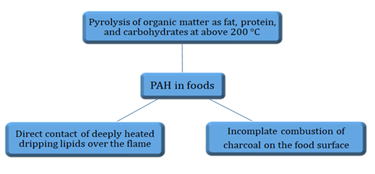- Submissions

Full Text
Novel Techniques in Nutrition and Food Science
An Overview the Toxicology of Benzo(a)pyrene as Biomarker for Human Health: A Mini-Review
Muharrem I1,3* and Kaplan IO2,3
1 Department of Chemistry and Chemical Processes, Turkey
2 Department of Gastronomy and Culinary Arts, Turkey
3 Munzur University Rare Earth Elements Application and Research Center, Turkey
*Corresponding author:Muharrem I, Department of Chemistry and Chemical Processes, Munzur University Rare Earth Elements Application and Research Center, Turkey
Submission: June 13, 2019;Published: July 02, 2019

ISSN:2640-9208Volume4 Issue2
Abstract
Research on food safety is attracting growing interest in the field of human health around the world. Hazardous compounds in foodstuff come from various sources including food processing and environmental pollution. In this mini-review, focus was on benzo[a]pyrene, an important member of polycyclic aromatic hydrocarbons, which is mutagenic and cause changes in DNA which may increase the cancer risk. It has been the focus of many studies because of biomarker property [1-6]. All health organizations such as IARC, USEPA, EFSA should continuously control the benzo[a]pyrene formation, especially in foods processed at high temperatures.
Keywords: Polycyclic aromatic hydrocarbons; Benzo(a)pyrene; Biomarker; Food stuff; Food safety; Human health
Introduction
Polycyclic aromatic hydrocarbons (PAHs) constitute a one class of hydrophobic organic compounds consisting at least two fused benzene rings. The PAH are a very well-known class of ubiquitous environmental agents which are detrimental to human health and some of them known contribute to cancers [7,8]. Numerous PAHs may be formed and released into ecosystem during industrial processes or other human activities. These compounds generally can be occurred incomplete combustion or pyrolysis of organic matters. In food, especially protein-rich food products, they may be formed during the food preparation process including grilling, smoking and roasting. Major sources of PAH contamination are food processing step at high temperatures through fat pyrolysis. Their formation is known to occur at temperatures above 200 °C and it is highly stimulated at temperatures over 700 °C (Figure 1); [9]. Because of PAHs’ lipophilic properties, they usually accumulate in the organism’s fatty tissues. Among the numerous PAHs, the best investigated is benzo(a)pyrene, which is often used as a biomarker for PAH in foodstuff [10]. Therefore, benzo(a)pyrene was classified as group 1 (carcinogenic to humans) by International Agency for Research on Cancer [11]. Because of carcinogenic, mutagenic and teratogenic properties, it has been classified by the USEPA as compound of probable human carcinogens [12]. Furthermore, in 2008, confirmed by the Scientific Committee on Foods that benzopyrene is genotoxic [9,13]. Because of carcinogenic risk for public health, many health organization and government and national authorities have set limits to control the level of benzo(a)pyrene in food to reduce public exposure [14]. The maximum acceptable benzo(a)pyrene concentrations have limited as 5μg kg-1 for smoked fish by European Commission [15]. On the other hands, maximum acceptable concentrations of benzo(a)pyrene has permitted as 2.0μg kg-1 in smoked fish by Turkish Codex Regulation [16,1]. Maximum benzo[a]pyrene admissible level has been specified by EC for different foods and range from 1µg kg-1 to 10µg kg-1 [17]. When benzo(a)pyrene entered the body, it leads to some health problems such as low IQ, low birth weight, growth retardation, small head circumference, damaged DNA in unborn children and the disruption of endocrine systems. Also, it can be cause early menopause due to destruction of ova besides the skin changes [18,8]. Researchers have also revealed that PAHs cause brain damage and behavior disorder and they could be transferred from mothers to newborns and young infants [19,20]. Because of its lipophilic and hydrophobic properties, benzo(a)pyrene can easily cross cell membranes and attend to bioaccumulate in lipid tissues. This effect is associated to metabolic activation to reactive diol-epoxide intermediates that can covalently bind DNA. Based on investigations, benzo(a)pyrene can be easily bind adenine and guanine to constitute diol-epoxide and the N6 of adenine and the N2 amino-group of guanines are main targets sites [17]. Because of genotoxicity properties, European Food Safety Authority (EFSA) attracted attention the levels of benzo(a)pyrene in foodstuff [21]. This autority to provide a comprehensive review about PAH toxicity in foodstuff, they selected benzo(a)pyrene as a PAH marker for food, in December 2002. For monitoring the PAH pollution profile, they also committed the need for additional PAHs. The other PAHs that needs for grouping were also addressed by the European Commission.
Figure 1:PAHs formation in foods [13].

Conclusion and Suggestions
The objectives of this study were to:
1. Evaluate the toxic effects of benzo(a)pyrene formation in the foods during the food processing.
2. Emphasize that various health authorities have identified benzo(a)pyrene as a biomarker for PAHs in foodstuff.
3. It is essential that benzo(a)pyrene maximum acceptable concentrations should be controlled by health authorities and monitored using scientific laboratory analysis for food products. For human, the major source of exposure to PAHs is may be diet.
References
16. Turkish Food Codex (2008) Turkish food codex communiqué on determining the maximum levels of certain contaminants in foodstuffs. The official gazette: 17.05.2008/26879.
21. European Food Safety Authority (EFSA) (2008) Scientific opinion of the panel on contaminants in the food chain. EFSA J 724: 1-114.
© 2019 Ramlachan N. This is an open access article distributed under the terms of the Creative Commons Attribution License , which permits unrestricted use, distribution, and build upon your work non-commercially.
 a Creative Commons Attribution 4.0 International License. Based on a work at www.crimsonpublishers.com.
Best viewed in
a Creative Commons Attribution 4.0 International License. Based on a work at www.crimsonpublishers.com.
Best viewed in 







.jpg)






























 Editorial Board Registrations
Editorial Board Registrations Submit your Article
Submit your Article Refer a Friend
Refer a Friend Advertise With Us
Advertise With Us
.jpg)






.jpg)














.bmp)
.jpg)
.png)
.jpg)










.jpg)






.png)

.png)



.png)






